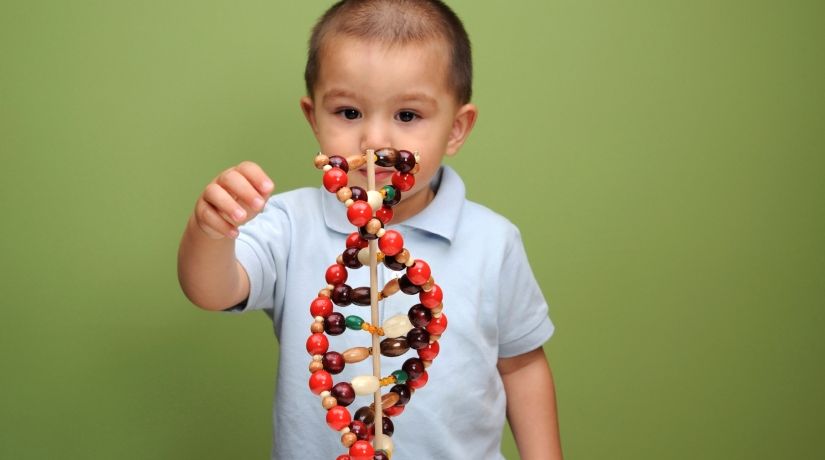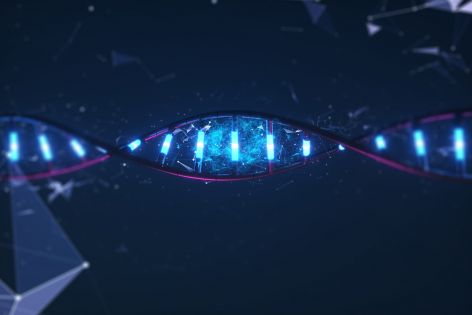DNA in living creatures shows strong evidence of a Creator. It carries information that cannot have occurred by natural forces but came by intelligent design.

Many people around the world do not believe that God exists, classifying themselves as atheists. Others believe that God exists, but they haven’t proven His existence. Still others, the agnostics, aren’t sure whether He exists or not.
“They are without excuse”
God has something to say about those who do not believe He exists: “For since the creation of the world His invisible attributes are clearly seen, being understood by the things that are made, even His eternal power and Godhead, so that they are without excuse” (Romans 1:20).
This scripture applies to all humans who have ever lived. From the beginning, people could see the things that were made by God and the incredible complexity and orderliness of the creation. But for thousands of years, mankind wasn’t aware of a magnificent part of creation that lies hidden within the cells of every living creature: DNA.
Discovery of DNA
Friedrich Miescher discovered DNA in the late 1860s. But many of its secrets were not unveiled till the 1950s.
In 1953 James Watson and Francis Crick became the first scientists to formulate an accurate description of the DNA molecule’s complex, double-helical structure.
Sequencing the human genome
Since the discovery of DNA, it has been a fascinating area of research. Scientists began sequencing the human genome in 1990, and a working draft was completed in the year 2000.
“It is humbling for me, and awe-inspiring, to realize that we have caught the first glimpse of our own instruction book, previously known only to God”—Francis Collins, director of the Human Genome Project.
On June 26, 2000, President Bill Clinton congratulated those who completed the human genome sequencing, and acknowledged DNA as God’s creation. He said, “Today we are learning the language in which God created life. We are gaining ever more awe for the complexity, the beauty, the wonder of God’s most divine and sacred gift.”
Dr. Francis Collins, director of the Human Genome Project, followed the president to the podium, stating, “It is humbling for me, and awe-inspiring, to realize that we have caught the first glimpse of our own instruction book, previously known only to God.”
What is amazing is that within the tiny space in every cell in your body, this code is 3 billion letters long!
DNA and intelligent design
But just what is DNA? If it is truly the creation of an intelligent and all-powerful Designer, we would expect that it would be accurate, optimally coded and an efficient method of storage.
We will address all of these aspects and then discuss what impact understanding this incredible molecule should have on our lives.
What is DNA?

DNA is an abbreviation for deoxyribonucleic acid. DNA is made up of four chemicals—adenine, guanine, cytosine and thymine—which are represented by the letters A, G, C and T.
The arrangement of these four bases, or nucleotides, serves as a recipe for cells to translate and then use in building proteins from amino acids. These proteins are then used in cellular functions—everything from growing your hair to turning your food into energy.
When Bill Gates took biology in high school, he found it boring. However, in his book The Road Ahead, he explains the concept that changed his mind completely:
“I entered my twenties convinced that chemistry was much more interesting than biology. Then I read James D. Watson’s Molecular Biology of the Gene, an excellent book that made me realize my high school experience had misled me. Biology, the understanding of life, is now much more interesting to me than chemistry. Biological information is the most important information we can discover, because over the next several decades it will revolutionize medicine and lead to treatments for most diseases. Human DNA is like a computer program but far, far more advanced than any software we’ve ever created” (1996, pp. 227-228, emphasis added).
Does DNA make mistakes?
“Human DNA is like a computer program but far, far more advanced than any software we’ve ever created”—Bill Gates.
DNA must reproduce itself every time a cell divides, so it is important that the code remains the same in all of an organism’s cells. The accuracy with which it reproduces is astounding, from the simplest single-celled organisms to the most complex multicellular creatures.
Let’s look at both ends of the spectrum: E. coli bacteria (a prokaryote—a cell without a nucleus, where the DNA is loose inside the cell) and humans (classified with the eukaryotes—creatures with cells that have nuclei to house their DNA).
“The single molecule of DNA that is the E. coli genome contains 4.7 x 106 nucleotide pairs. DNA replication begins at a single, fixed location in this molecule, the replication origin, proceeds at about 1000 nucleotides per second, and thus is done in no more than 40 minutes. And thanks to the precision of the process (which includes a ‘proof-reading’ function), the job is done with only about one incorrect nucleotide for every 109 nucleotides inserted. In other words, more often than not, the E. coli genome (4.7 x 106) is copied without error!
“The average human chromosome contains 150 x 106 nucleotide pairs which are copied at about 50 base pairs per second. The process would take a month (rather than the hour it actually does) but for the fact that there are many places on the eukaryotic chromosome where replication can begin. … As replication nears completion, ‘bubbles’ of newly replicated DNA meet and fuse, finally forming two new molecules” (G. Tripathi, Cellular and Biochemical Science, p. 353).
Is DNA optimally coded?
Twenty different amino acids make up proteins in the human body, so the four bases, or letters, must somehow code for each one. From an engineering standpoint, is DNA optimally coded? Four letters make up the alphabet and sets of three letters make up the words, or codons.
According to Werner Gitt, information scientist and author, there are four requirements for the most efficient code:
- The code should use the least material to unambiguously code for at least the 20 amino acids.
- As the number of characters in the alphabet increases, the complexity of the execution machinery also increases. This requires more material and results in more errors during replication, transcription and translation.
- Because of the DNA replication system (whereby the double helix is unzipped and each of the single strands receives complementary letters), the number of letters in the alphabet must be even.
- In order to reduce errors during many of the copying processes, it is necessary to incorporate redundancy.
Dr. Gitt concludes: “From an engineering point of view, and under the criteria that were considered here, the code system used in living organisms for protein synthesis—the Quaternary Triplet Code—is the best of all possible codes considering the four requirements that must be met. This testifies to purposeful design” (Without Excuse, 2011, p. 211).
How efficiently does DNA store data?
DNA the size of a pinhead contains as much information as 25 trillion 189-page paperback books.
Since DNA uses the least material to code for the 20 amino acids, it is very efficient from a data storage viewpoint. Dr. Gitt gives the following examples to illustrate this efficiency:
- DNA the size of a pinhead contains as much information as 25 trillion 189-page paperback books. A pile of these books would stretch 920 times the distance from the earth to the moon.
- If you were to stretch out one milligram of a double helix strand of DNA material, it would almost stretch from the earth to the moon (Without Excuse, p. 288).
In fact, DNA’s amazing storage capacity has prompted some scientists to attempt to harness it for data storage! ExtremeTech reported that “a bioengineer and geneticist at Harvard’s Wyss Institute successfully stored 5.5 Petabits of data—around 700 terabytes—in a single gram of DNA.”
Why evolution is impossible
Dr. Gitt, a former professor of information systems, explains, “The basic flaw of all evolutionary views is the origin of the information in living beings. It has never been shown that a coding system and semantic information could originate by itself [through matter]. … The information theorems predict that this will never be possible. A purely material origin of life is thus [ruled out]” (In the Beginning Was Information, 2005, p. 123).
It is literally impossible that DNA, in all its majestic complexity, accuracy and necessity to life, could have evolved.
It is literally impossible that DNA, in all its majestic complexity, accuracy and necessity to life, could have evolved. This would be like saying that Darwin’s Origin of the Species came into existence without a writer or a preexisting concept of language!
Several notable scientists who were formerly proponents of evolution have reversed their views based on the discoveries of the information found in DNA.
Dean Kenyon, a biology professor who repudiated his earlier book on Darwinian evolution, stated: “This new realm of molecular genetics [is] where we see the most compelling evidence of design on the Earth” (quoted by Lee Strobel in The Case for a Creator, 2004, p. 221).
One of the world’s most famous atheists, Professor Antony Flew, admitted he couldn’t explain how DNA was created and developed through evolution, and came to accept the need for an intelligent source to have been involved in the making of the DNA code.
“At age 81, after decades of insisting belief is a mistake, Antony Flew has concluded that some sort of intelligence or first cause must have created the universe. A super-intelligence is the only good explanation for the origin of life and the complexity of nature, Flew said in a telephone interview from England. …
“Biologists’ investigation of DNA ‘has shown, by the almost unbelievable complexity of the arrangements which are needed to produce [life], that intelligence must have been involved,’ Flew says in the new video, ‘Has Science Discovered God?’” (Richard Ostling, “Leading Atheist Now Believes in God,” Dec. 9, 2004).
What does the design of DNA mean for you?
The discovery of the structure of DNA in 1953 led to the understanding of how information in the form of a code was necessary for life. But such complex information cannot originate from material simply falling into place; it has to come from an intelligent Creator.
The DNA replication process shows how this information is passed on with very little error using a code that is optimally designed to build the proteins necessary for life.
Today, with advances in technology, we can see some of the smallest parts of God’s creation, providing further evidence of God’s intelligent design.
God and DNA
Reproduction and life itself provide awesome testimony to the creative genius of God. As David expressed it poetically:
“For You formed my inward parts; You covered me in my mother’s womb. I will praise You, for I am fearfully and wonderfully made; marvelous are Your works, and that my soul knows very well” (Psalm 139:13-14).
David even hints at God’s knowledge of the information that makes us before we are even formed: “Your eyes saw my substance, being yet unformed. And in Your book they all were written, the days fashioned for me, when as yet there were none of them” (verse 16).
Our loving Creator knows our physical makeup, down to the level of DNA. But even more important, He has a plan for transforming us to become like Him—the children of God!
The apostle John wrote, “Behold what manner of love the Father has bestowed on us, that we should be called children of God!” (1 John 3:1). We are to “be like Him” (verse 2), developing the spiritual DNA displayed in the fruit of the Spirit.
Learn more in our articles “How to Become a Child of God” and “The Fruit of the Spirit.”
Evidence of Creation
Study DNA and other wonders of God’s creation, and you will find evidence of intelligent design.
“What may be known of God is manifest in them, for God has shown it to them. For since the creation of the world His invisible attributes are clearly seen, being understood by the things that are made, even His eternal power and Godhead, so that they are without excuse” (Romans 1:19-20).
Are you willing to see the evidence of God in His creation? Will you prove to yourself that He exists? And if He does, will you seek to obey Him?
Additional articles on this subject can be found in our section “Is There a God?”




